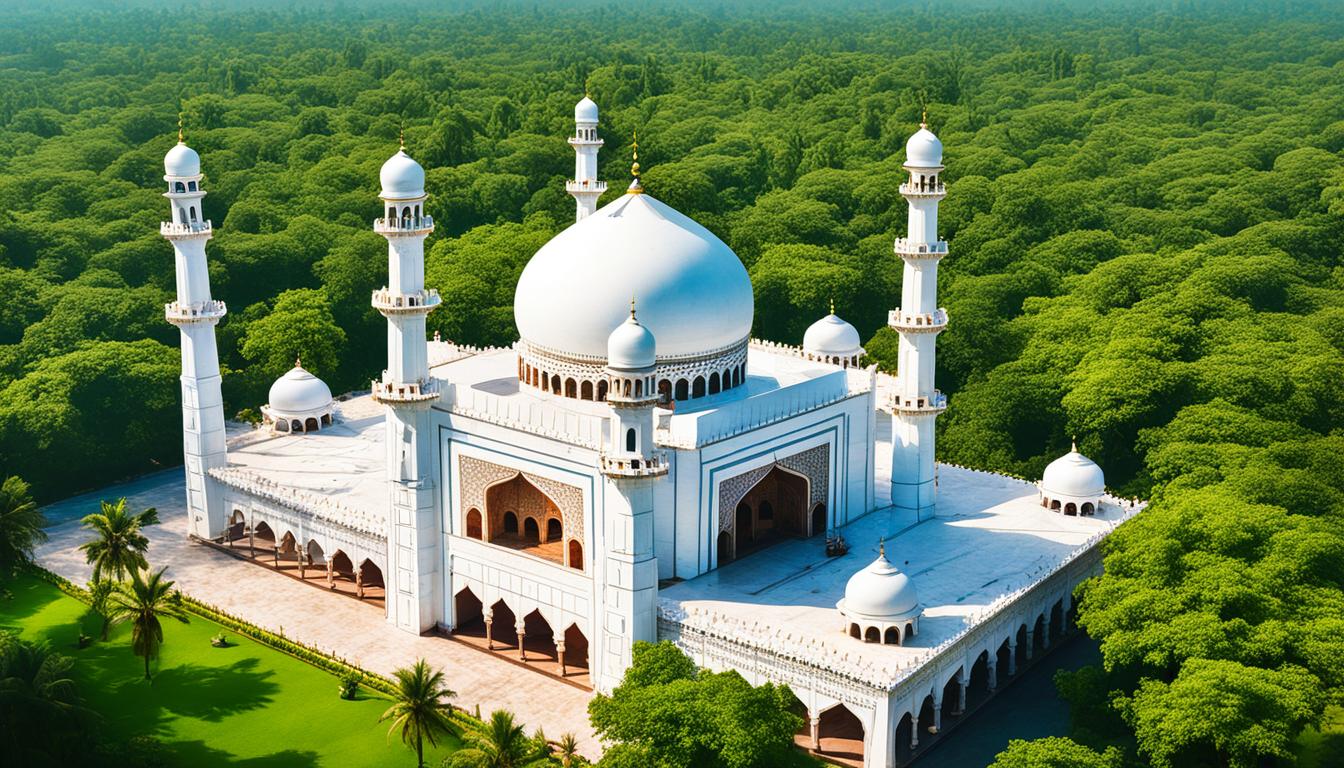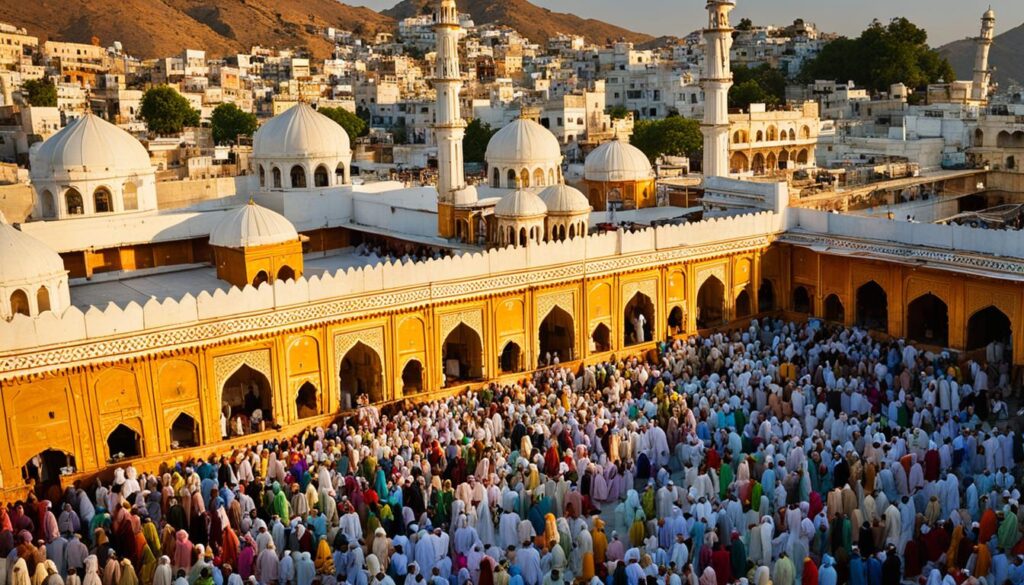
Discover India’s Majestic Mosques: A Spiritual Journey
Did you know that India is not only home to over 200 million Muslims, but also houses some of the most magnificent mosques in the world? These architectural marvels, scattered across the country, are not just religious sites but also cultural heritage treasures that attract millions of tourists every year. From the stunning Islamic architecture to the spiritual significance they hold, the mosques in India offer a unique and captivating experience for those seeking a spiritual journey.
As you embark on this virtual tour, you will delve into the enchanting world of Islamic architecture, explore the rich history of religious sites in India, and discover the diverse cultural tapestry that makes this country so unique. Get ready to witness the grandeur of the Taj-ul-Masajid in Bhopal, the spiritual aura of Jama Masjid in Delhi, and the serene beauty of Hazratbal Shrine in Srinagar.
Join us as we take you on a spiritual sojourn through the mosque-filled landscape of India, where you will uncover the hidden gems of Islamic heritage and immerse yourself in the rich cultural tapestry of this remarkable country.
Varanasi: The World Capital of Hinduism
Varanasi, located in the state of Uttar Pradesh, holds a unique position as the spiritual capital of India. Known as Kashi in Hindu mythology, it is considered one of the oldest continuously inhabited cities in the world. Varanasi is not only famous for its sacred river, the Ganges, but also for its ancient temples that dot its spiritual landscape.
One of the most revered temples in Varanasi is the Kashi Vishwanath Temple, dedicated to Lord Shiva, one of the principal deities in Hinduism. This iconic temple, also known as the Golden Temple, is a significant pilgrimage site for Hindus. Devotees from all over the world come here to seek blessings and spiritual solace.
Another noteworthy site in Varanasi is the Bhart Mata Temple, which translates to the “Mother India Temple.” This unique temple depicts a map of India carved on a marble relief, symbolizing the unity and religious tolerance that defines the Indian heritage. The temple stands as a testimony to the unifying principles of Hinduism and the nation’s rich cultural diversity.
“Varanasi, with its ancient temples and vibrant spiritual atmosphere, is a truly enchanting destination that captures the essence of Hinduism and offers a transformative experience.”
Exploring the Ancient Temples of Varanasi
Varanasi is home to numerous ancient temples, each with its own unique history and architectural grandeur. These temples not only provide a glimpse into the rich religious traditions of Hinduism but also serve as centers of spiritual rejuvenation.
- Kashi Vishwanath Temple: With its ornate architecture and elaborate rituals, this temple attracts millions of devotees year-round. It is believed that a visit to this temple can wash away sins and grant liberation from the cycle of birth and death.
- Bhart Mata Temple: The intricate marble relief depicting the map of India in this temple is a testament to India’s religious harmony and acceptance. It symbolizes the unity that transcends religious boundaries and reflects the core values of Hinduism.
- Other Ancient Temples: Varanasi is also home to numerous other temples, such as the Sankat Mochan Hanuman Temple and the Durga Temple, each with its own mythology and significance in Hinduism. Exploring these temples is like delving into the mystical world of gods and goddesses.
Visiting Varanasi is a spiritual journey like no other. The ancient temples, the mystical rituals, and the mystical aura of this sacred city create an atmosphere that is truly transformative. It is a place where devotees can connect with their inner self and experience the essence of spirituality.
Immerse yourself in the ancient temples of Varanasi and embark on a spiritual pilgrimage that will leave an indelible mark on your soul. Witnessing the religious tolerance, deep spirituality, and cultural heritage of this vibrant city is an experience that every spiritual seeker should undertake.
Tirupati: A Center for Pilgrims
Tirupati, located in Andhra Pradesh, is a major pilgrimage center in India. The city is renowned for the Venkateswara temple on the sacred Tirumala hill, which attracts thousands of religious travelers. The temple holds significant religious importance for Hindus and offers a spiritual experience like no other. A visit to Tirupati is a must for those seeking a deep connection with their faith.
As one of the most famous pilgrimage centers in India, Tirupati welcomes millions of devotees every year. The Venkateswara temple, also known as the Tirumala temple, stands as a testament to the unwavering devotion of the Hindu community. Dedicated to Lord Venkateswara, an incarnation of Lord Vishnu, the temple represents spiritual purity and divine blessings.
The journey to the temple includes climbing the legendary Tirumala hill through a series of steps known as “Seva” or “Darshan.” While it may be physically challenging, the pilgrimage is a symbol of deep faith and devotion. As devotees ascend the steps, they leave behind their worldly troubles, immersing themselves in a spiritual experience that rejuvenates the mind, body, and soul.
1. The Majestic Venkateswara temple

At the heart of Tirupati’s spiritual aura lies the Venkateswara temple, a magnificent structure adorned with intricate carvings and sculptures. The temple’s architectural grandeur showcases the rich cultural heritage of Andhra Pradesh.
2. Divine Offerings and Rituals
Pilgrims visiting the Venkateswara temple have the opportunity to participate in various rituals and offer prayers to seek blessings. The most significant offering is the Laddu prasadam, a sweet treat that is believed to symbolize divine grace. Devotees also engage in daily prayers, including the chanting of hymns and the recitation of sacred texts.
“The Tirupati pilgrimage is not just a spiritual journey but also a testament to the unbreakable bond between man and the divine. It transforms lives, instills humility, and strengthens faith.” – Anonymous
3. Tirumala Brahmotsavam
Tirupati is famous for its annual festival called the Tirumala Brahmotsavam, a grand celebration of Lord Venkateswara. This nine-day extravaganza showcases a vibrant display of religious rituals, colorful processions, and cultural performances. It is believed that participating in the Brahmotsavam during this auspicious time bestows immense blessings and spiritual fulfillment.
4. Accommodations and Facilities
To cater to the needs of the countless devotees, Tirupati offers a range of accommodation options, including guesthouses and budget-friendly lodges. Free meals, known as Annaprasadam, are provided to pilgrims at various locations in and around the temple complex, ensuring their physical and spiritual well-being.
Pilgrimage Highlights |
Facilities |
|---|---|
|
|
Ajmer: A sacred shrine for Muslims
Ajmer, located in Rajasthan, is home to the revered Ajmer-e-Sharif, also known as the Dargah, the final resting place of Sufi Saint Khwaja Moinuddin Chishti. This shrine holds immense importance for Muslims and attracts devotees from all over the world. The annual Urs festival commemorating the death anniversary of Khwaja Moinuddin Chishti is a significant event where thousands of pilgrims gather to offer their prayers.
Ajmer is a place of deep spiritual significance and a testament to India’s religious diversity.

| Significance | Location | Features |
|---|---|---|
| Ajmer-e-Sharif | Rajasthan | – Final resting place of Sufi Saint Khwaja Moinuddin Chishti – Importance for the Muslim community – Attracts devotees from around the world |
| Urs festival | Rajasthan | – Commemorates the death anniversary of Khwaja Moinuddin Chishti – Thousands of pilgrims gather to offer prayers – A significant religious event |
Amritsar: The Golden Temple
Located in Amritsar, the Golden Temple, also known as Harmandir Sahib or Darbar Sahib, stands as one of the most revered sites for Sikhs. This majestic temple is a spiritual haven, attracting devotees from all corners of the world. The Golden Temple is a mesmerizing sight, with its stunning white and gold architecture reflecting in the serene pool that surrounds it.
The Golden Temple holds tremendous significance as it houses the Granth Sahib, the holy book of the Sikhs. Devotees gather here to seek solace and connect with their faith, immersing themselves in the tranquil atmosphere and the teachings of Sikhism.
One of the most remarkable aspects of the Golden Temple is the langar, a free community kitchen that serves meals to all visitors without distinction. This practice, known as seva, is a demonstration of equality and selfless service, embodying the principles of Sikhism. The langar feeds thousands of people every day, making it the largest free kitchen in the world.
The Golden Temple is a testament to the rich Sikh heritage, spirituality, and the values of inclusivity and compassion. It is a place that showcases the devotion and unity of the Sikh community and invites people from all walks of life to experience its sacredness and serenity.
Goa: Home to Ancient Churches
Though not typically known as a religious destination, Goa is a treasure trove of ancient churches that bear witness to the region’s colonial history and cultural influences. These magnificent structures showcase the enduring impact of Jesuit architecture and provide a glimpse into the religious heritage of the area.
One of the most notable churches in Goa is the Basilica of Bom Jesus. This iconic church not only exemplifies the classic forms of Jesuit architecture but also houses the revered relics of St. Francis Xavier, a prominent figure in Catholicism. The church’s baroque facade, adorned with intricate carvings and sculptures, is a testament to the artistic prowess and devotion of the era. Inside, an art gallery featuring exquisite paintings and sculptures depicting biblical scenes further enriches the visitor’s experience.
“The ancient churches of Goa stand as a testament to the rich cultural and religious heritage of the region. These architectural marvels offer visitors a glimpse into the past and a chance to immerse themselves in the sacred atmosphere of these sacred spaces.”
Exploring the ancient churches of Goa provides a unique opportunity to dive deep into the region’s history and witness the convergence of cultural influences. The exquisite craftsmanship and artistic details found within these churches serve as reminders of a bygone era and highlight the cultural significance of Goa in the broader religious landscape.
Prominent Ancient Churches in Goa:
| Church Name | Location | Architectural Style |
|---|---|---|
| Se Cathedral | Old Goa | Portuguese-Manueline |
| Church of St. Francis of Assisi | Old Goa | Portuguese-Gothic |
| Church of Our Lady of the Immaculate Conception | Panaji | Portuguese-Baroque |
| Church of St. Cajetan | Old Goa | Italian-Baroque |
Visiting these ancient churches in Goa is an unforgettable experience for history enthusiasts, architecture admirers, and spiritual seekers alike. It allows for a deeper understanding of the cultural complexities and religious influences that have shaped the region over centuries.
Conclusion
Embarking on a spiritual journey through the mosques of India is an enriching experience, where travelers can witness the fusion of Islamic architecture, cultural heritage, and religious devotion. The mosques in India not only serve as historical monuments but also offer a deep connection with spirituality and a glimpse into the vibrant culture of the country.
From the ancient mosques in Varanasi, showcasing religious tolerance and unity, to the sacred shrine of Ajmer, symbolizing India’s religious diversity, each mosque tells a unique story of faith and history. Exploring these majestic mosques is a way to immerse oneself in the rich cultural heritage of India, where historical monuments hold immense significance.
Whether you are a religious traveler seeking a spiritual experience or a cultural enthusiast craving to explore the architectural gems of India, the mosques in India should be on your itinerary. They provide an opportunity to embrace the religious diversity and historical legacy of the country, offering a memorable and inspiring journey through the spiritual realms of India.
Source Links
- https://contendingmodernities.nd.edu/field-notes/exploring-indias-pluralism/
- https://www.forbes.com/sites/ministryoftourismindia/2019/01/23/embark-on-a-spiritual-journey-of-discovery/
- https://zeezest.com/travel/from-north-to-south-india-s-most-renowned-mosques-4563

Leave a Reply